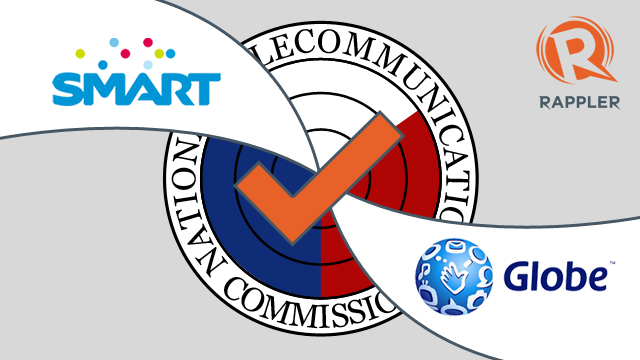SUMMARY
This is AI generated summarization, which may have errors. For context, always refer to the full article.

MANILA, Philippines – Smart Communications Inc. has once again come out at the forefront of the telco race after topping the Quality of Service (QoS) benchmarking test conducted by the National Telecommunications Commission (NTC) in the first quarter of 2013.
In a statement released by the NTC on Monday, April 1, the industry regulator revealed that both Smart Communications and Globe Telecom, the two biggest telecommunication company in the country, passed the QoS test.
The Pangilinan-led company, however, performed better than its Ayala-led rival for the second time in a row. In the 4th quarter of 2012, Smart edged Globe and performed better in the same battery of tests.
The results of the first quarter 2013 tests were as follows:
| Indicator | Industry standard | Globe Telecom | SMART Communications |
|
BLOCKED CALL RATE |
4% or less, or no more than 4 blocked calls for every 100 call attempts | 2.6% | 0.87% |
|
DROPPED CALL RATE |
2% or less | 1.53% | 1% |
|
SIGNAL STRENGTH |
Average Receive Signal Level (ARSL) at -85dBm or more. Figures closer to 0 is deemed better | -71.14 dBm | -65.90 dBm |
|
SIGNAL QUALITY |
Average Signal Quality (ASQ) in the 0 to 4 range. Figures closer to 0 is deemed better | 0.91 | 0.77 |
|
CALL SET-UP TIME |
14 seconds or less | 12.20 seconds | 11.06 seconds |
The results of the 4th quarter 2012 tests were as follows:
| Indicator | Industry standard | Globe Telecom | SMART Communications |
|
BLOCKED CALL RATE |
4% or less | 2% | 1% |
|
DROPPED CALL RATE |
2% or less | 1.2% | 1% |
|
SIGNAL STRENGTH |
-85dBm or more. | -71.78 dBm | -64.49 dBm |
|
SIGNAL QUALITY |
0 to 4 range | 0.94 | 0.67 |
|
CALL SET-UP TIME |
14 seconds or less | 11.98 seconds | 11.12 seconds |
Declines, improvements
Despite passing the QoS test, both telecom companies showed declines in service quality compared to the 4th quarter of 2012.
Smart’s performance declined in 2 of the 5 indicators
- the Average Receive Signal Level (ARSL) declined to -65.90dBm from -64.49dBm
- Average Signal Quality (ASQ) declined to 0.77 from 0.67
Smart’s Dropped Call Rate remained at 1% in the two consecutive quarters.
Globe, on the other hand, posted declines in 3 of the 5 indicators.
- Blocked Calls declined to 2.6% from 2%
- Dropped Calls to 1.53% from 1.2%
- Call Set-up Time to 12.20 seconds from 11.98 seconds
Globe cited the ongoiing modernization program for these declines.
“Changes in the results could be attributed to the time when the tests were done, during which, we may be calibrating our transmission capabilities,” corporate communications head Yoly Crisanto said in a statement.
ARSL and ASQ posted positive developments for the Ayala-led company. ARSL improved to -71.14dBm from -71.78dBm and ASQ to 0.91 from 0.94, both in Q1 2013 and Q4 2012, respectively.
Modernization
Smart Communications welcomed this positive development. “We are happy that the NTC results show consistent improvement(s) in our overall network service quality and that Smart maintains clear superiority in providing quality service,” it said in a statement.
Smart further highlighted that this is the second time that Smart came out on top in all 5 indicators and that the result “encourages (Smart) to step up efforts to ensure (that) customers get the best possible service.”
Globe also welcomed the test results, saying that the positive results are indicative of the company’s commitment in providing better services to their clients.
“We were confident that we will pass all the metrics and we did. Our network modernization is progressively moving forward,” Crisanto said.
Both companies have been making efforts to drastically improve their network and coverage services at the beginning of 2012.
Smart finished its P67 billion modernization program in the first half of 2012.
Globe, on the other hand, is expected to complete its $700 million network modernization program in 2013. Crisanto mentioned that the first phase of the modernization program has already been completed and that the company is expecting to “continuously show improvement” in the succeeding quarters.
It is interesting to see test results for the next quarters once Globe finishes its modernization plans, keeping it in toe with Smart, which already finished its modernization plans.
The QoS test was conducted on Globe’s and Smart’s postpaid Subscriber Identity Module (SIM) cards with customers subscribed to regular services and not unlimited services. Sun, Talk and Text, Red Mobile and Touch Mobile SIMs were not used because these SIMs were sharing the networks of either Globe or Smart.
The NTC monitoring teams surveyed 1,500 calls per network across all of the 17 cities of Metro Manila.
The test was conducted for one week each January, February and March 2013. – with Lean Santos/Rappler.com
Add a comment
How does this make you feel?
There are no comments yet. Add your comment to start the conversation.